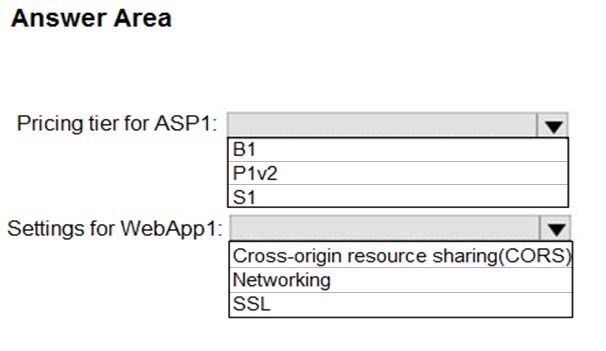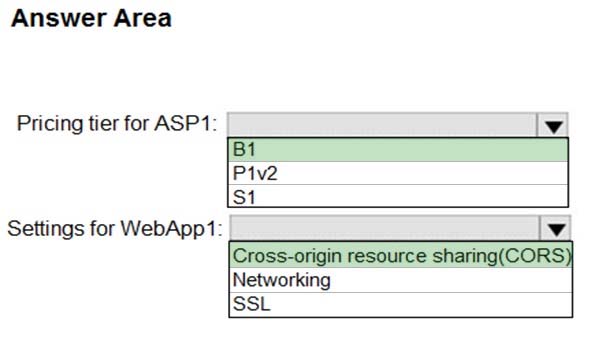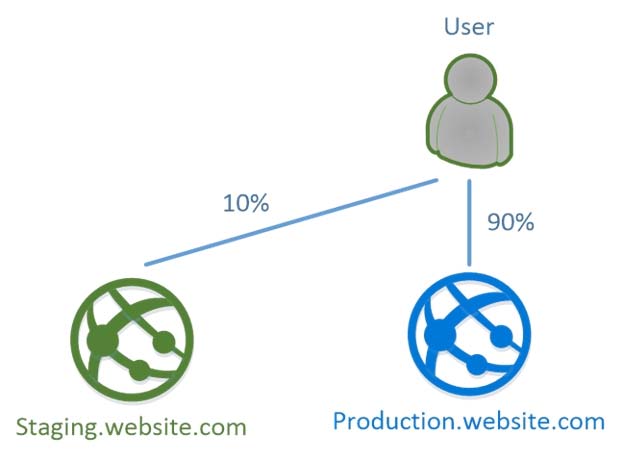Microsoft AZ-101 Exam Practice Questions (P. 3)
- Full Access (103 questions)
- Six months of Premium Access
- Access to one million comments
- Seamless ChatGPT Integration
- Ability to download PDF files
- Anki Flashcard files for revision
- No Captcha & No AdSense
- Advanced Exam Configuration
Question #11
You are building a custom Azure function app to connect to Azure Event Grid.
You need to ensure that resources are allocated dynamically to the function app. Billing must be based on the executions of the app.
What should you configure when you create the function app?
You need to ensure that resources are allocated dynamically to the function app. Billing must be based on the executions of the app.
What should you configure when you create the function app?
- Athe Windows operating system and the Consumption plan hosting plan
- Bthe Windows operating system and the App Service plan hosting plan
- Cthe Docker container and an App Service plan that uses the B1 pricing tier
- Dthe Docker container and an App Service plan that uses the S1 pricing tier
Correct Answer:
A
Azure Functions runs in two different modes: Consumption plan and Azure App Service plan. The Consumption plan automatically allocates compute power when your code is running. Your app is scaled out when needed to handle load, and scaled down when code is not running.
Incorrect Answers:
B: When you run in an App Service plan, you must manage the scaling of your function app.
References:
https://docs.microsoft.com/en-us/azure/azure-functions/functions-create-first-azure-function
A
Azure Functions runs in two different modes: Consumption plan and Azure App Service plan. The Consumption plan automatically allocates compute power when your code is running. Your app is scaled out when needed to handle load, and scaled down when code is not running.
Incorrect Answers:
B: When you run in an App Service plan, you must manage the scaling of your function app.
References:
https://docs.microsoft.com/en-us/azure/azure-functions/functions-create-first-azure-function
send
light_mode
delete
Question #12
Note: This question is part of a series of questions that present the same scenario. Each question in the series contains a unique solution that might meet the stated goals. Some question sets might have more than one correct solution, while others might not have a correct solution.
After you answer a question in this section, you will NOT be able to return to it. As a result, these questions will not appear in the review screen.
You have an Azure Active Directory (Azure AD) tenant named Adatum and an Azure Subscription named Subscription1. Adatum contains a group named
Developers. Subscription1 contains a resource group named Dev.
You need to provide the Developers group with the ability to create Azure logic apps in the Dev resource group.
Solution: On Subscription1, you assign the Logic App Operator role to the Developers group.
Does this meet the goal?
After you answer a question in this section, you will NOT be able to return to it. As a result, these questions will not appear in the review screen.
You have an Azure Active Directory (Azure AD) tenant named Adatum and an Azure Subscription named Subscription1. Adatum contains a group named
Developers. Subscription1 contains a resource group named Dev.
You need to provide the Developers group with the ability to create Azure logic apps in the Dev resource group.
Solution: On Subscription1, you assign the Logic App Operator role to the Developers group.
Does this meet the goal?
- AYes
- BNo
Correct Answer:
B
The Logic App Operator role only lets you read, enable and disable logic app. With it you can view the logic app and run history, and enable/disable. Cannot edit or update the definition.
You would need the Logic App Contributor role.
References:
https://docs.microsoft.com/en-us/azure/role-based-access-control/built-in-roles https://docs.microsoft.com/en-us/azure/logic-apps/logic-apps-securing-a-logic-app
B
The Logic App Operator role only lets you read, enable and disable logic app. With it you can view the logic app and run history, and enable/disable. Cannot edit or update the definition.
You would need the Logic App Contributor role.
References:
https://docs.microsoft.com/en-us/azure/role-based-access-control/built-in-roles https://docs.microsoft.com/en-us/azure/logic-apps/logic-apps-securing-a-logic-app
send
light_mode
delete
Question #13
HOTSPOT -
You have an Azure web app named WebApp1 that runs in an Azure App Service plan named ASP1. ASP1 is based on the D1 pricing tier.
You need to ensure that WebApp1 can be accessed only from computers on your on-premises network. The solution must minimize costs.
What should you configure? To answer, select the appropriate options in the answer area.
Each correct selection is worth one point.
NOTE:
Hot Area:

You have an Azure web app named WebApp1 that runs in an Azure App Service plan named ASP1. ASP1 is based on the D1 pricing tier.
You need to ensure that WebApp1 can be accessed only from computers on your on-premises network. The solution must minimize costs.
What should you configure? To answer, select the appropriate options in the answer area.
Each correct selection is worth one point.
NOTE:
Hot Area:

Correct Answer:

Box 1: B1 -
B1 (Basic) would minimize cost compared P1v2 (premium) and S1 (standard).
Box 2: Cross Origin Resource Sharing (CORS)
Once you set the CORS rules for the service, then a properly authenticated request made against the service from a different domain will be evaluated to determine whether it is allowed according to the rules you have specified.
Note: CORS (Cross Origin Resource Sharing) is an HTTP feature that enables a web application running under one domain to access resources in another domain. In order to reduce the possibility of cross-site scripting attacks, all modern web browsers implement a security restriction known as same-origin policy.
This prevents a web page from calling APIs in a different domain. CORS provides a secure way to allow one origin (the origin domain) to call APIs in another origin.
References:
https://azure.microsoft.com/en-us/pricing/details/app-service/windows/ https://docs.microsoft.com/en-us/azure/cdn/cdn-cors

Box 1: B1 -
B1 (Basic) would minimize cost compared P1v2 (premium) and S1 (standard).
Box 2: Cross Origin Resource Sharing (CORS)
Once you set the CORS rules for the service, then a properly authenticated request made against the service from a different domain will be evaluated to determine whether it is allowed according to the rules you have specified.
Note: CORS (Cross Origin Resource Sharing) is an HTTP feature that enables a web application running under one domain to access resources in another domain. In order to reduce the possibility of cross-site scripting attacks, all modern web browsers implement a security restriction known as same-origin policy.
This prevents a web page from calling APIs in a different domain. CORS provides a secure way to allow one origin (the origin domain) to call APIs in another origin.
References:
https://azure.microsoft.com/en-us/pricing/details/app-service/windows/ https://docs.microsoft.com/en-us/azure/cdn/cdn-cors
send
light_mode
delete
Question #14
HOTSPOT -
You have an Azure web app named WebApp1.
You need to provide developers with a copy of WebApp1 that they can modify without affecting the production WebApp1. When the developers finish testing their changes, you must be able to switch the current line version of WebApp1 to the new version.
Which command should you run prepare the environment? To answer, select the appropriate options in the answer area.
Each correct selection is worth one point.
NOTE:
Hot Area:

You have an Azure web app named WebApp1.
You need to provide developers with a copy of WebApp1 that they can modify without affecting the production WebApp1. When the developers finish testing their changes, you must be able to switch the current line version of WebApp1 to the new version.
Which command should you run prepare the environment? To answer, select the appropriate options in the answer area.
Each correct selection is worth one point.
NOTE:
Hot Area:

Correct Answer:

Box 1: New-AzureRmWebAppSlot -
The New-AzureRmWebAppSlot cmdlet creates an Azure Web App Slot in a given a resource group that uses the specified App Service plan and data center.
Box 2: -SourceWebApp -
References:
https://docs.microsoft.com/en-us/powershell/module/azurerm.websites/new-azurermwebappslot

Box 1: New-AzureRmWebAppSlot -
The New-AzureRmWebAppSlot cmdlet creates an Azure Web App Slot in a given a resource group that uses the specified App Service plan and data center.
Box 2: -SourceWebApp -
References:
https://docs.microsoft.com/en-us/powershell/module/azurerm.websites/new-azurermwebappslot
send
light_mode
delete
Question #15
You have an Azure App Service plan that hosts an Azure App Service named App1.
You configure one production slot and four staging slots for App1.
You need to allocate 10 percent of the traffic to each staging slot and 60 percent of the traffic to the production slot.
What should you add to App1?
You configure one production slot and four staging slots for App1.
You need to allocate 10 percent of the traffic to each staging slot and 60 percent of the traffic to the production slot.
What should you add to App1?
- Aslots to the Testing in production blade
- Ba performance test
- Ca WebJob
- Dtemplates to the Automation script blade
Correct Answer:
A
Besides swapping, deployment slots offer another killer feature: testing in production. Just like the name suggests, using this, you can actually test in production.
This means that you can route a specific percentage of user traffic to one or more of your deployment slots.
Example:

References:
https://stackify.com/azure-deployment-slots/
A
Besides swapping, deployment slots offer another killer feature: testing in production. Just like the name suggests, using this, you can actually test in production.
This means that you can route a specific percentage of user traffic to one or more of your deployment slots.
Example:

References:
https://stackify.com/azure-deployment-slots/
send
light_mode
delete
All Pages
